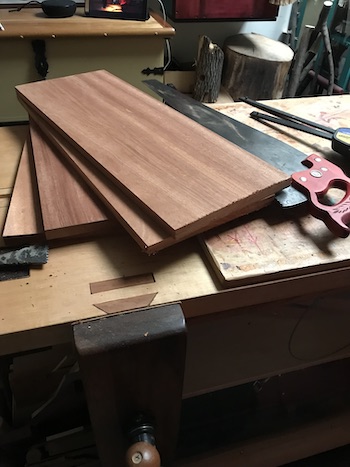Growth. That’s what I want. And practice. And doing. Oh yes… and actual experience. All of these lead to the “G” word or growth. How could it not?
My build for the shop altar continues.
I made a list of tasks remaining to be done. By the last post, the altar cabinet top, bottom, and sides were already cut. Then I planed the faces, edges and sides to size. What’s next on the list?
Part 4
Make dovetails, not waste
Lay out one dovetail. Cut one dovetail. Learn something. Do it again. Remember?
There are many methods that woodworkers use for making dovetails. Since this project was for something larger than simply 6 inch square blocks to practice on, I could not afford to make many mistakes. I could not simply toss a botched board to the side and start over. This was something I really cared about. It was an “investment” that I could not mess up.
Although my experience with dovetails was growing, it was not extensive. I needed to use a method that would bolster my confidence and skills as I progressed.
Which one? I used a modified tape method (with blue painters tape) to mark the dovetail boundary or scribe line on the outside face of the altar cabinet pieces. Keeping the dovetail bottom or floor straight and crisp is a problem for me. The tape served as a very visible guide for placing my chisel at the scribe line.
Cutting the tail board
I marked the face and edges for five dovetails on the cabinet sides. These were measured out using dividers. Then I used a 1:6 dovetail marker to “angle” or slope the tails. Each dovetail is 1-3/8″, the pins are 3/8″, and half-pins are 1/4″. In the back of my mind, I was concerned that the small size of the half dovetails would be problematic. We’ll see.
I took my time marking, then, cutting the tails.
After cutting the tails with a dovetail saw, I used a fret saw to cut out and remove the unwanted or waste wood. Next I cleaned up any remaining dovetail waste with a chisel.
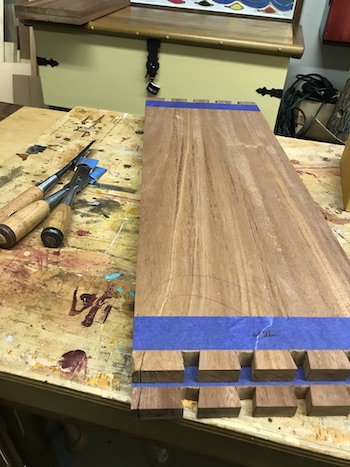
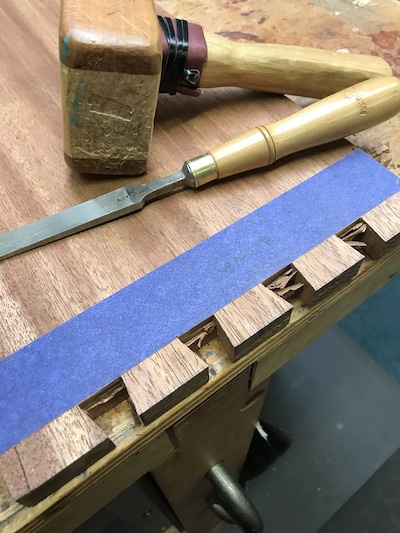
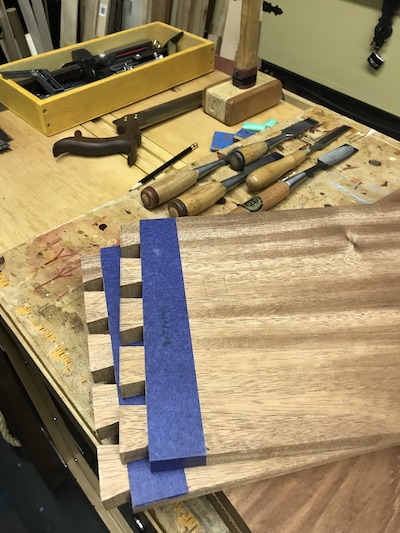
Growth came looking for me
My entire personality changed. This was not practice anymore. I was much more methodical and took my time cutting these tails. My sawing was more focused, too. Practice didn’t make perfect, but it is making it better. I think it shows in the results!
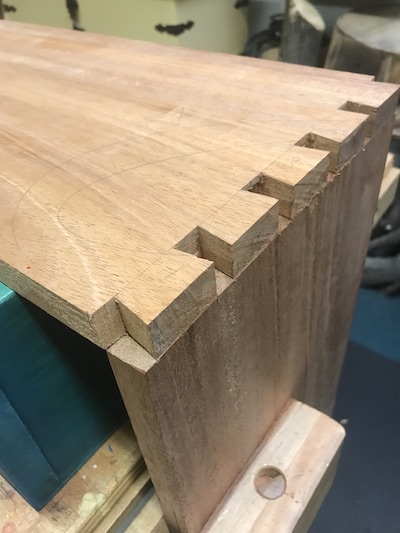
Now, I marked the pins using the tail boards as templates. Here, great care was made to match the proper ends to each other.
I used narrow color-coded tape to match each cabinet side (top and bottom) to the proper sides of the cabinet top and cabinet bottom. Yellow tape indicated the cabinet top, red tape for the bottom, and blue tape for the outside face of the pieces.
This helped reduce the potential for error when the time came for marking the pins. Importantly, it will help to match the corresponding edges when I begin assembling the cabinet. Again, I took my time matching top to top and bottom to bottom.
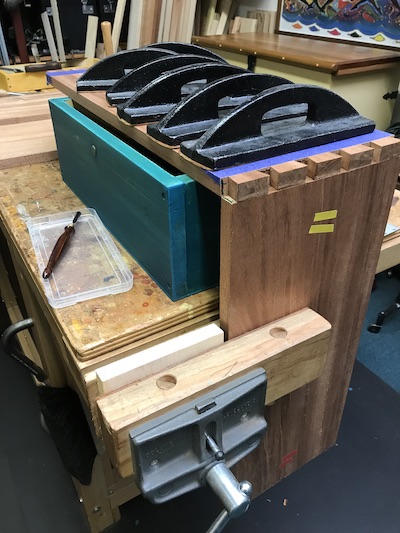
That tail board did not move! See the set-up in action:
The pin boards
Once the pins are cut, a little cleaning or finagling clears the waste.
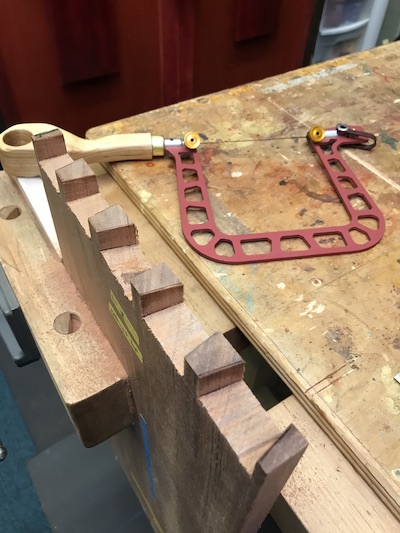
While I was cutting the pin waste block, I made a mistake while cutting it with the fret saw. I got a little too close to the scribe line. Actually, I breached it!
So, I’m trying to figure why this happened. You see how I tried to deny involvement… like I didn’t do it? I had not taped this board to the scribe line. I saw that I hadn’t, but I thought I could execute my cutting and sawing tasks without it. Hmph! That may have been a reason for my straying beyond the line. Sawing too fast with the fret saw, maybe? I grew a little too restless? Perhaps I was feeling a bit bossy after my success with cutting the tails? Bottom line: I was not paying attention.
An Unexpected repair
Fortunately, I had not mangled or thrown away the waste block. I glued it back onto the board edge and taped it down. I let it dry overnight and, this time, carefully cut out the waste from the reattached pin waste (aka tail socket) the best that I could. Fortunately this repair is on the board for the cabinet bottom!
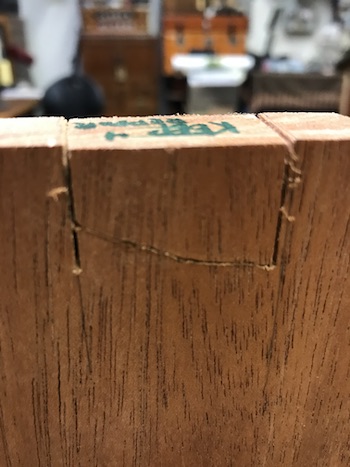
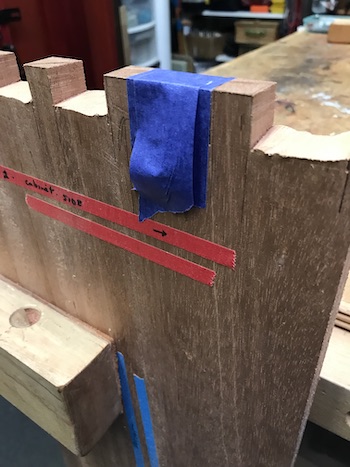
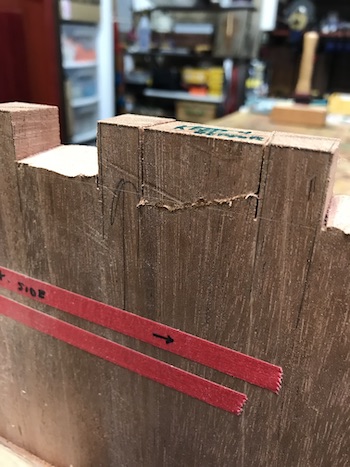
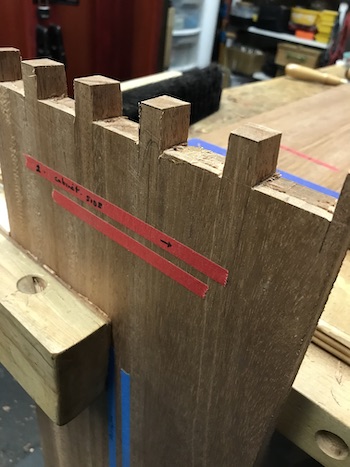
No need to panic. I made the repair and moved on. That is the growth and the real lesson.
Tails to pins
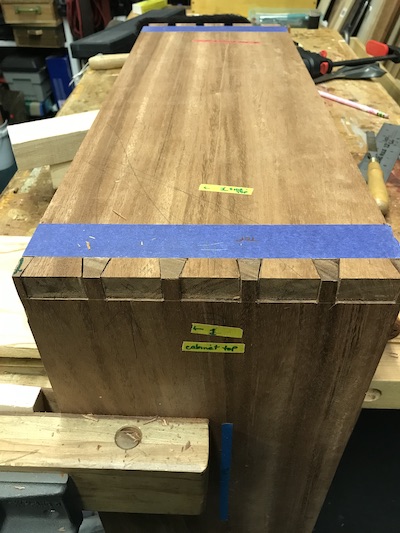
Yes, it looked a little rustic but I put these dovetails together for an actual project! This task took a lot of sweat and brain power, but they fit and I learned a lot.
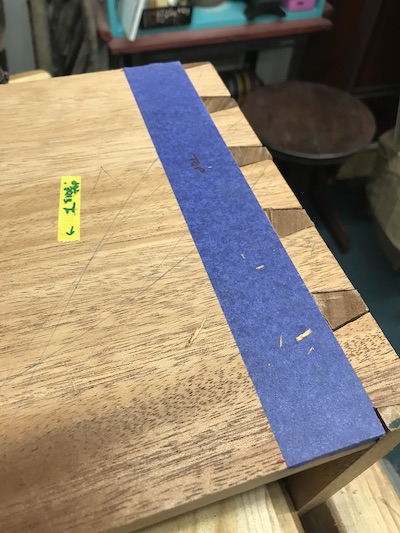
and pin board (cabinet bottom).
If you really think clearly about it, the origins of a mistake can be traced. Sometimes unconsciously, we deny that an action that we were adamant to take was the cause. We just cannot believe that we had a conscious hand in it. A cutting or fitting error, for example, might be traced to a desire to omit a seemingly minor adjustment or measurement. We foolishly rush in where… you get it. I have done it and made quite a few mistakes.
In any case, perfection will always be accepted but if it is not to be, I lend myself support. And learn a lot. This is what I remember: one step begets the other. Perfect form yields a perfect result. A mistake, however, yields a lesson.
I am satisfied for now. I will show more work and progress growth in the next post.
Caution: Mischievous Musing
It seems that I am making things up as I go — again. I just might work better that way, maybe. It keeps things flexible and agile (in my mind at least) to add or subtract details as I work, maybe. It helps me to cheerfully remedy mistakes. After all, it does not get in the way of me growing into a fearless woodworker. Well, that’s what I tell myself. Just remember that few things in my shop are entirely random.
__________
What Birthdays Are For
Birthdays are perfect for thinking about how I’ve grown as a human being. A good question that I ask myself is this: how have I changed and improved since my last b-day?
I am ever hopeful. Still, I look for ways to get better, not only in woodworking but in everything I do in life. I like to think I have a plan, at best unofficial, to achieve large and small goals. I evaluate my habits – all of them – and vow to tweak them and work on them for the coming year. Oh dear!
Some periods of our growth are so confusing that we don’t even recognize that growth is happening. We may feel hostile or angry or weepy and hysterical, or we may feel depressed. It would never occur to us, unless we stumbled on a book or a person who explained to us, that we were in fact in the process of change…
– Alice Walker
And it is never too late to grow.
Baadaye.
Shirley J ♥️
Happy birthday week to me! 🌹
_________
Next time: More work on the shop Altar project.

